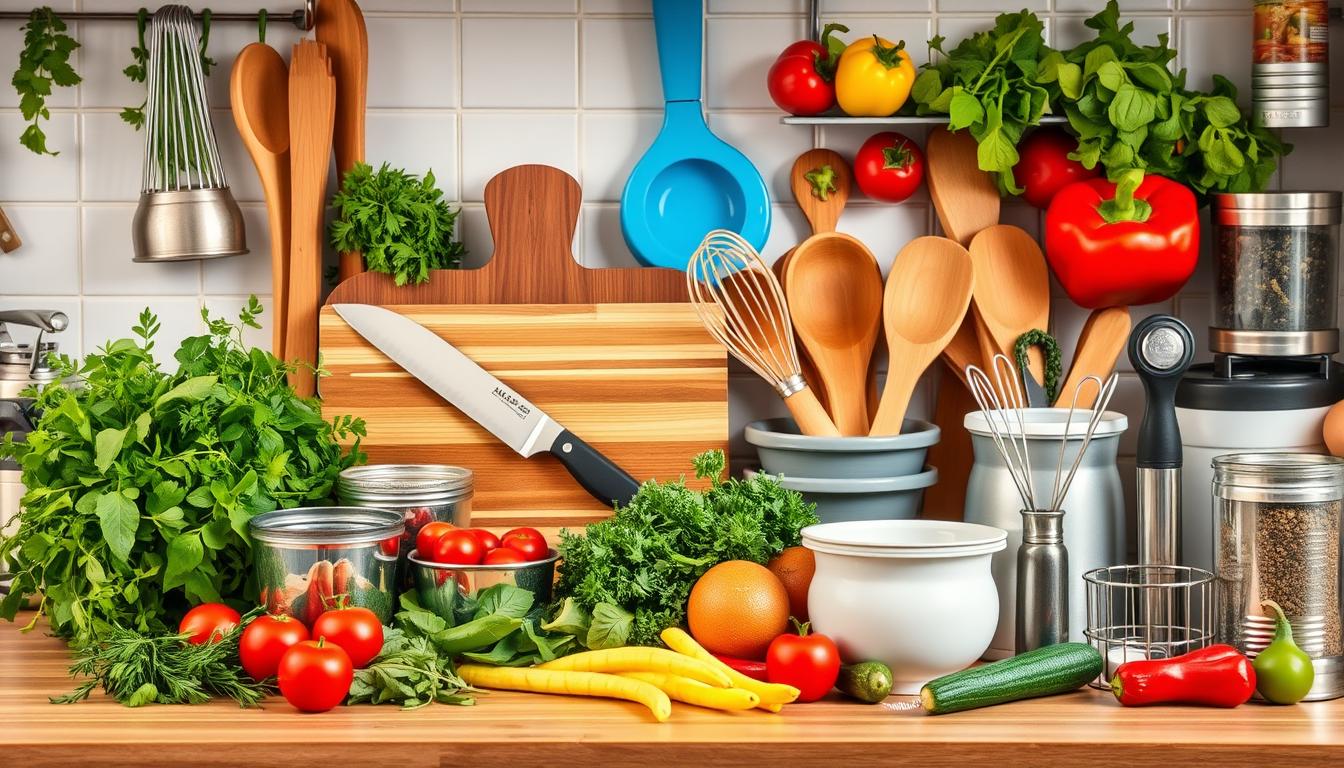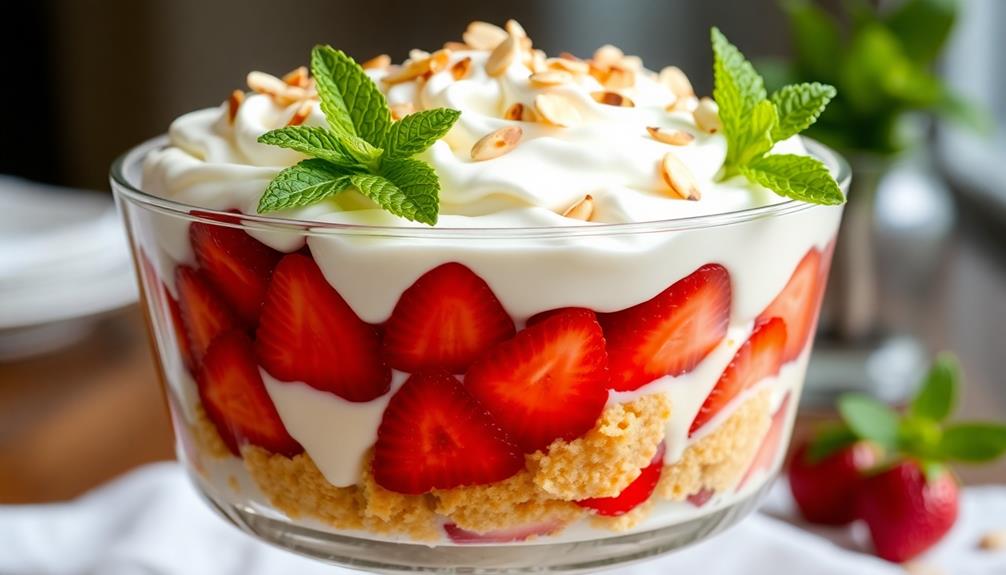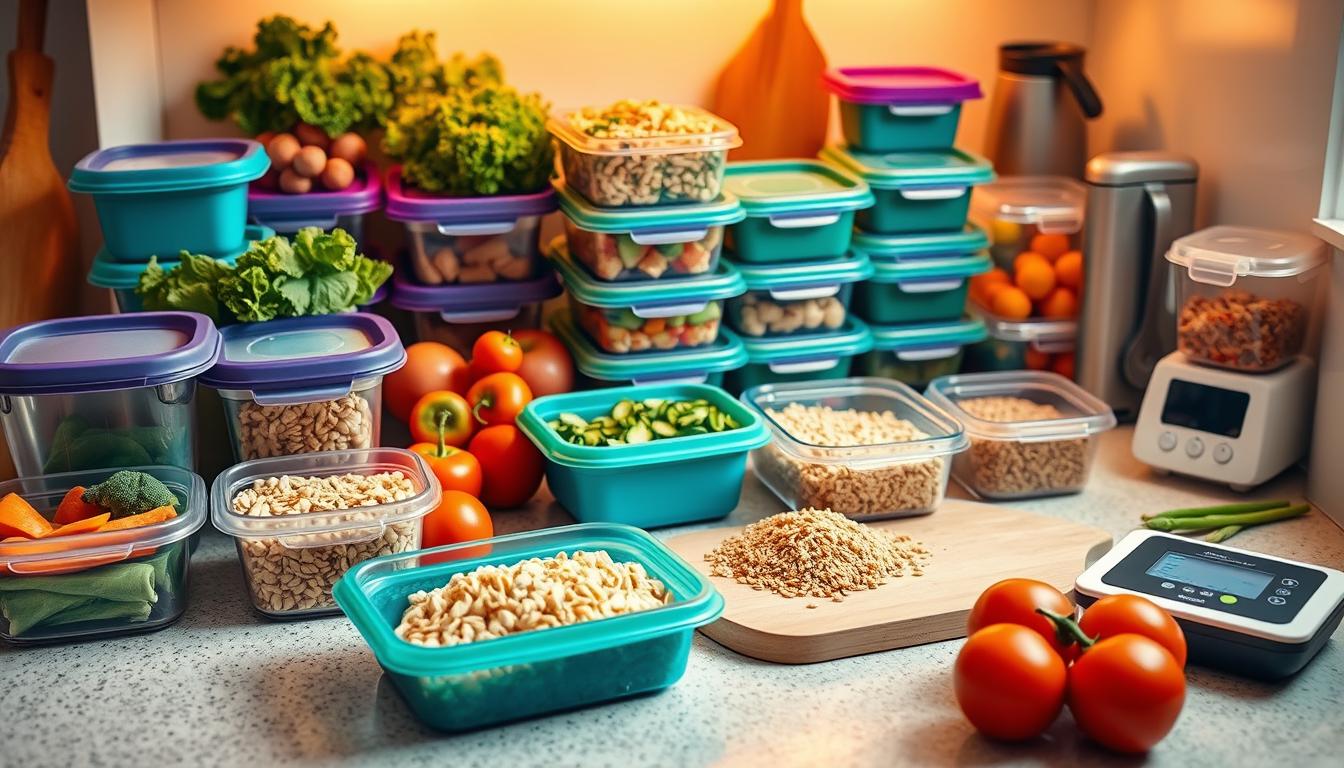Imagine stepping into your kitchen, where the aroma of fresh ingredients wafts through the air. You reach for the tools that will help you create culinary magic, transforming simple components into spectacular dishes—this is where the heart of your cooking journey begins. Having the right essential cooking tools makes all the difference, not just in how you cook but also in how you feel about cooking. A well-equipped kitchen can inspire confidence, encourage creativity, and evoke joy in the art of preparing meals.
From a sharp chef’s knife that effortlessly glides through vegetables to a sturdy cutting board that can withstand the rigors of everyday meal prep, the right kitchen essentials enhance your culinary experience. Investing in quality cooking tools and gadgets opens up a world of possibilities, allowing you to experiment with new recipes and hone your skills. With well-chosen utensils at your side, you are not just a cook, you become a creator, crafting meals that can bring family and friends together around the table.
Key Takeaways
- The right essential cooking tools can enhance joy and confidence in the kitchen.
- Quality kitchen essentials allow for creativity and experimentation with meals.
- A good chef’s knife is vital for efficient and precise food preparation.
- Investing in durable gadgets ensures long-term benefits and improved cooking experiences.
- A well-equipped kitchen is key to creating restaurant-level meals at home.
Understanding the Importance of Kitchen Essentials
The importance of kitchen essentials cannot be overstated when striving for effective cooking and enjoyable culinary experiences. Investing in the right cooking equipment allows you to streamline your processes, leading to time-saving benefits that enhance overall efficiency. For example, using the appropriate tools helps you complete tasks quickly, which is particularly valuable in fast-paced cooking environments.
Quality kitchen tools also play a critical role in improving the outcome of your dishes. Precision instruments like measuring cups and meat thermometers are vital for consistency, especially in baking and ensuring meats are cooked safely. By achieving the correct internal temperatures, you significantly influence the taste and texture of your meals.
Furthermore, safety measures in the kitchen are greatly reinforced by using suitable equipment. The right tools help protect both cooks and diners from potential hazards, ensuring that food preparation adheres to safe consumption standards. This dedication to safety supports better kitchen hygiene and minimizes the risk of foodborne illnesses. In addition, following basic kitchen safety tips, such as keeping knives sharpened and using heat-resistant gloves when handling hot cookware, can also contribute to a safer cooking environment. It’s important to always be mindful of potential dangers and to take the necessary precautions. By staying informed and educated on kitchen safety tips, cooks can help maintain a secure and hygienic environment for preparing and serving food to others.
By focusing on the importance of kitchen essentials, you can enhance your cooking experience, build confidence in trying complex recipes, and improve operational efficiency, whether at home or in a commercial setting. High-quality kitchen tools empower you to express your creativity while making cooking more enjoyable and rewarding.

Essential Cooking Tools and Gadgets for Every Home Chef
For every home chef, having the right tools makes a significant difference in creating culinary masterpieces. Among the most crucial of these tools is the chef’s knife, a versatile implement that performs a variety of tasks in the kitchen. From chopping and mincing to slicing and dicing, a quality chef’s knife embodies essential cooking tools every culinary enthusiast should possess.
The Versatility of Chef’s Knives
Chef’s knives are renowned for their ability to tackle multiple kitchen tasks effortlessly. Their sharp blades and ergonomic handles provide precision and comfort, making them a favorite among cooks. A well-balanced knife reduces fatigue during prolonged use, while various blade materials can enhance performance and longevity. The Misen Chef’s Knife, for instance, is acclaimed for its ease of use and effectiveness, showing how the right cooking equipment can elevate your culinary experience.
Your Guide to Choosing the Right Chef Knife
Selecting the perfect chef’s knife can feel overwhelming. Consider the following key features:
- Balance: A balanced knife feels comfortable in your hand, allowing for better control.
- Weight: Personal preference plays a significant role; some prefer lighter knives for agility, while others favor heavier options for more substantial cuts.
- Blade Material: Stainless steel and high-carbon steel are popular choices. Each has its benefits; stainless steel is corrosion-resistant, while high-carbon steals its edge retention capabilities.
For those on a budget, the Victorinox 8 Inch Fibrox Pro Chef’s Knife boasts a strong user review base on Amazon, making it an excellent option. On the higher-end spectrum, brands like Wüsthof provide premium knives designed for serious chefs. Regardless of price, choosing the right chef’s knife ensures your skill in the kitchen will shine.
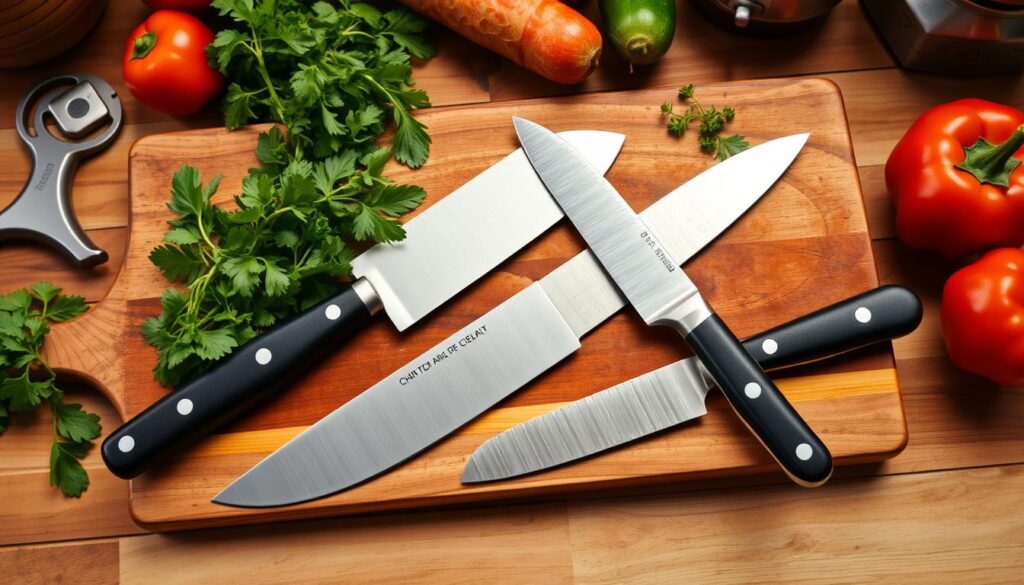
Must-Have Kitchen Utensils
Having the right kitchen utensils is essential for any home chef. These culinary accessories play a vital role in handling an array of cooking techniques, making your culinary adventures more enjoyable and efficient. From versatile spatulas to essential whisks, this section will explore the types of kitchen utensils you should consider and tips to choose the best ones for your needs.
Types of Kitchen Utensils You Should Own
- Spatulas: Ideal for flipping, spreading, and scraping.
- Whisks: Necessary for mixing and aerating ingredients.
- Wooden Spoons: Great for stirring without scratching cookware.
- Measuring Cups and Spoons: Essential for accuracy in recipes.
- Slotted Spoons: Useful for serving and draining liquids.
- Peelers: Effective for preparing fruits and vegetables.
How to Choose the Best Kitchen Utensils
Selecting the right kitchen utensils involves considering materials, usability, and durability. High-quality culinary accessories can make a significant difference in your cooking. When choosing kitchen utensils, keep these factors in mind:
- Material: Opt for heat-resistant silicone or stainless steel for longevity.
- Design: Ergonomic grips improve comfort during prolonged use.
- Functionality: Multipurpose tools, such as a spatula and a whisk in one, save space.
- Storage: Consider using a magnetic knife strip or utensil holder to keep your tools organized.
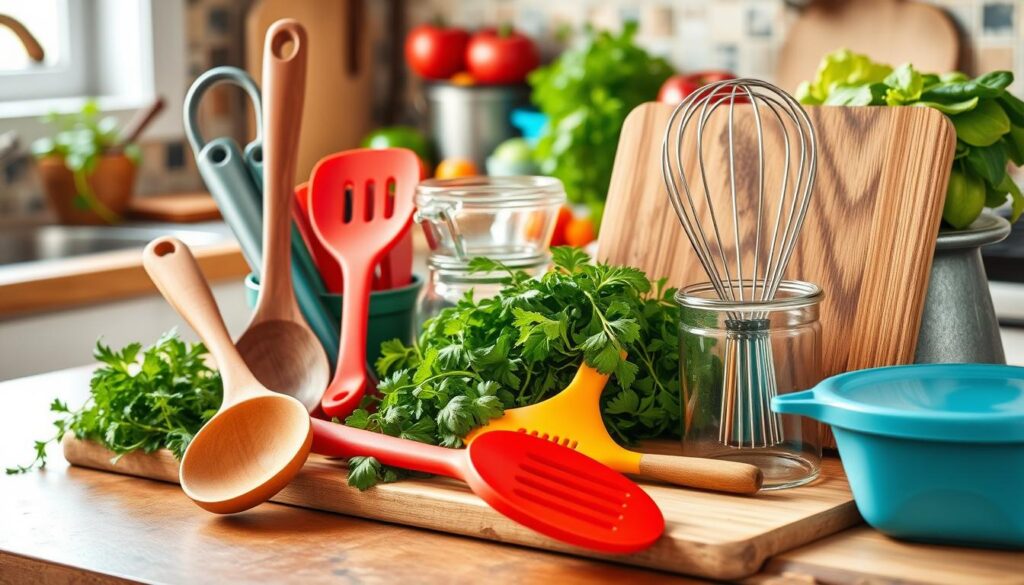
Effective use of kitchen utensils not only streamlines your cooking process but also enhances the overall quality of your meals. Investing in well-crafted cooking tools and gadgets, including utensils tailored to various tasks, will elevate your culinary experience and support a deeper connection with your food preparation. Choosing your kitchen utensils wisely makes a world of difference in how efficiently and enjoyably you cook.
The Importance of a Quality Cutting Board
A quality cutting board is a crucial element in your kitchen essentials. Choosing the right cutting board not only enhances your cooking experience but also ensures food safety and efficient meal preparation. The cutting board importance cannot be overstated, as it serves as the foundation for your cooking activity, affecting everything from sanitation to knife longevity.
Wood cutting boards have long been favored for their knife-friendly surface and durability. While they may come with a higher price tag—often exceeding $100 for a handcrafted butcher block—the investment pays off in longevity and performance. Properly maintained wooden boards can last for years, providing a stable and attractive surface for your culinary tasks.
Bamboo cutting boards offer a sustainable alternative without sacrificing quality. They tend to be more affordable than traditional wood options while still providing a durable surface. Plastic cutting boards are the go-to choice in many professional environments like restaurants and culinary schools due to their ease of cleaning. A good-quality plastic board can be found for approximately $20, combining affordability with practicality.
For versatility, silicone cutting boards provide a modern option available in various colors and thicknesses, while marble boards excel in specific tasks such as rolling out pastry dough due to their chilled surface. It’s important to note that glass cutting boards, while visually appealing, can be harsh on your knife edges and are better suited for serving rather than chopping.
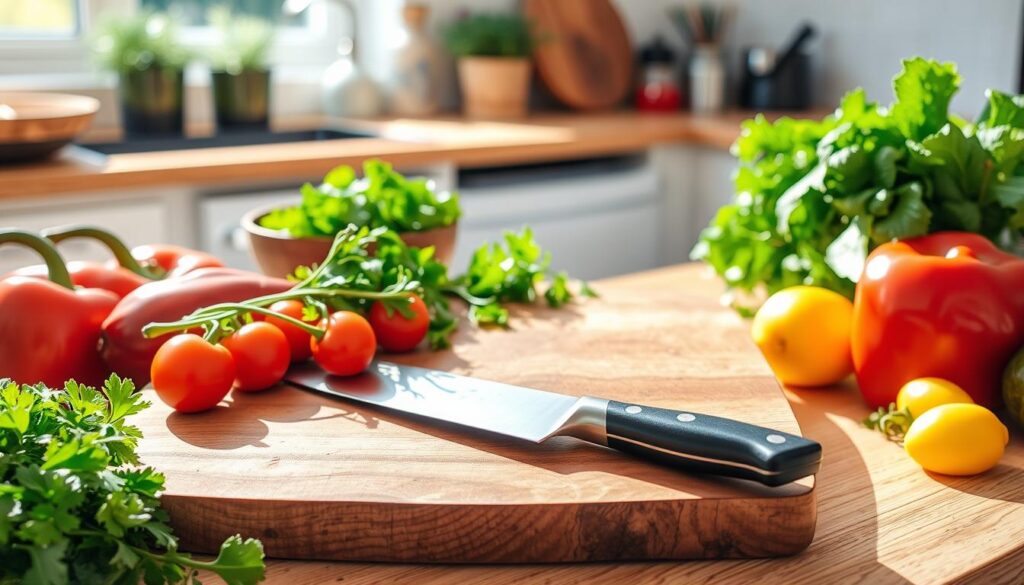
| Material | Durability | Care | Typical Cost |
|---|---|---|---|
| Wood | High | Oiling, hand wash | Over $100 |
| Bamboo | Moderate | Hand wash | Varies |
| Plastic | Moderate | Dishwasher safe | ~$20 |
| Silicone | Moderate | Dishwasher safe | Varies |
| Marble | High | Wipe clean | Varies |
| Glass | Low | Wipe clean | Varies |
When investing in cutting boards as part of your cooking equipment, consider having multiple boards to avoid cross-contamination. Each material has its own benefits and maintenance requirements, allowing you to choose the best option tailored to your cooking style.
Cookware You Can’t Live Without
Choosing the right cookware can significantly enhance your culinary experience. Your selection not only affects the quality of your meals but can also streamline your cooking process. Understanding the various materials available is crucial for optimizing your cooking style. Whether you lean towards stainless steel, nonstick, or cast iron, every type brings its unique benefits to your kitchen essentials.
Selecting the Right Cookware Material
The material you choose for your cookware plays a key role in your cooking success. Here’s a brief overview of common materials:
- Stainless Steel: Great for browning and deglazing, offering durability and even heat distribution.
- Nonstick: Ideal for low-fat cooking; food slides off easily, making cleaning a breeze.
- Cast Iron: Excellent heat retention, perfect for frying, baking, and slow-cooking.
When selecting your cookware, consider factors like the types of dishes you enjoy preparing and your personal cooking style. Quality pieces, such as Lodge cast iron skillets, offer versatility and are highly recommended for their performance and affordability.
Lodge Cast Iron Skillets: A Best-Seller
Lodge cast iron skillets are a staple in many kitchens. Their ability to retain heat makes them perfect for everything from frying eggs to baking cornbread. Affordable and durable, they often outshine competitors in both price and performance, making them a smart investment for any home chef. Here are some features that highlight their popularity:
| Feature | Description |
|---|---|
| Heat Retention | Maintains consistent heat for even cooking. |
| Versatility | Can be used on the stove top and in the oven. |
| Durability | Lasts for generations when cared for properly. |
| Affordability | Competitive pricing compared to similar products. |
Investing in high-quality cookware enhances not just your cooking experience, but also the overall quality of the meals you create. With essential cooking tools like Lodge skillets in your arsenal, you will feel empowered to tackle any recipe.
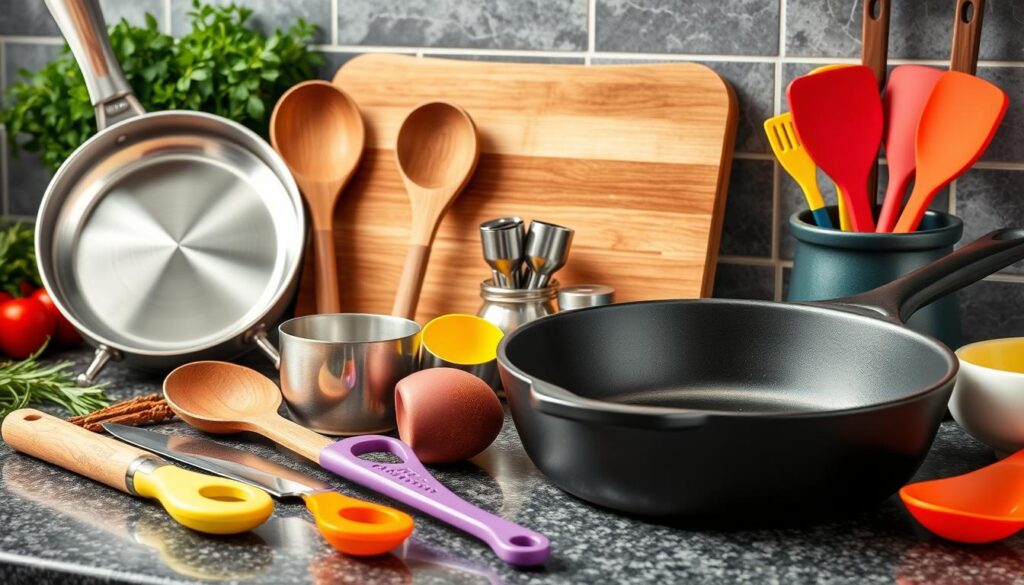
Food Preparation Tools: Streamlining Your Cooking Process
In the world of effective cooking, having the right food preparation tools significantly enhances your kitchen performance. A range of options can simplify the cooking process, making meal prep quicker and more efficient. Food processors, immersion blenders, and electric multi-cookers provide versatility while ensuring delicious results.
Consider adding items like silicone baking mats, which not only simplify clean-up but also reduce your reliance on parchment paper. For those who enjoy baking, using a cookie dropper allows you to create uniform cookie shapes effortlessly. Bench scrapers make transferring chopped ingredients a breeze, while flexible plastic cutting boards are dishwasher safe for easy maintenance.
Below is a selection of highly-rated food preparation tools that can significantly improve your kitchen essentials:
| Tool | Function | Key Feature | Recommended Brands |
|---|---|---|---|
| Food Processor | Chopping, slicing, dicing | Versatile for various tasks | Breville, Ninja |
| Immersion Blender | Pureeing soups, smoothies | Easily blend in the pot | Vitamix, Mueller Austria |
| Electric Multi-Cooker | Pressure cooking, slow cooking | Time-saving options | Instant Pot |
| Air Fryer | Cooking with less oil | Healthier cooking alternative | DASH |
| Food Thermometer | Ensuring doneness | Safety in cooking | Various brands |
These food preparation tools not only save time but also elevate your culinary skills. By investing in quality kitchen essentials, you set the stage for successful and enjoyable cooking experiences. Whether you’re making Sunday sauces in a durable cast iron pot or preparing weeknight meals in an Instant Pot, these tools enable efficiency and consistency in your kitchen.
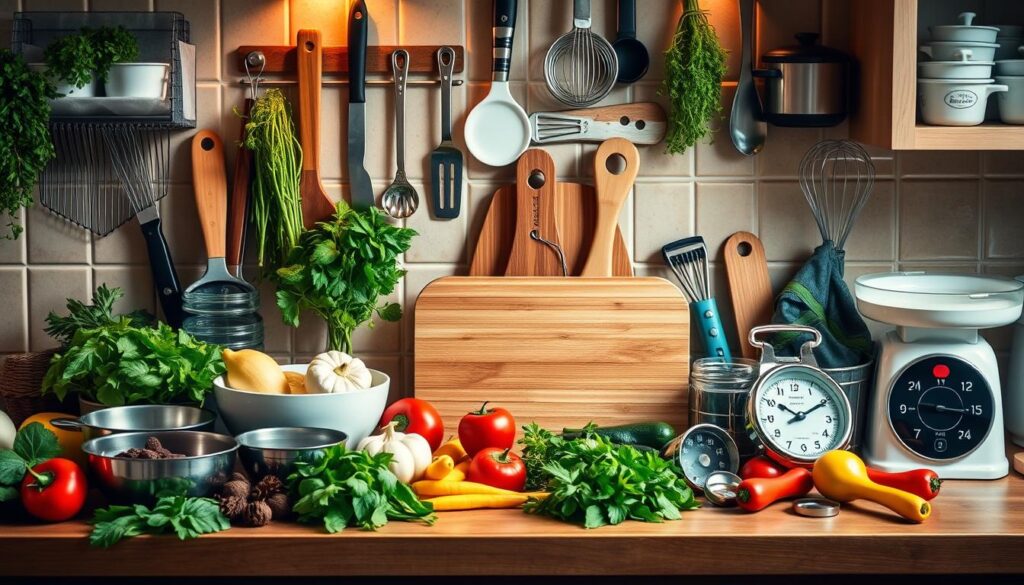
Softening Your Kitchen Experience with Stand Mixers
Stand mixers are essential kitchen gadgets that can simplify a variety of cooking tasks. They not only save you time but also enhance your overall cooking experience. With powerful motors and multiple attachments, these cooking tools can tackle everything from mixing dough to whipping cream. The convenience of stand mixers allows you to focus more on creativity in the kitchen rather than the labor-intensive aspects of cooking.
Benefits of Using a Stand Mixer
Stand mixers offer a multitude of benefits that can transform your culinary adventures:
- Time-Saving: Prepping ingredients becomes less tedious, letting you mix batter or dough hands-free.
- Consistent Results: Achieving the perfect texture is effortless, leading to better baking results.
- Versatile Attachments: Many stand mixers come with attachments that allow for additional functions like pasta making and food grinding.
Top Brands to Consider
When investing in a stand mixer, it is important to consider quality brands that stand the test of time. Here are some top choices:
| Brand | Notable Features | Price Range |
|---|---|---|
| KitchenAid | Multiple attachments, various colors | $300 – $600 |
| Bosch | Larger capacity, built-in scale | $399 – $599 |
| Breville | Smart features, powerful motor | $399 – $499 |
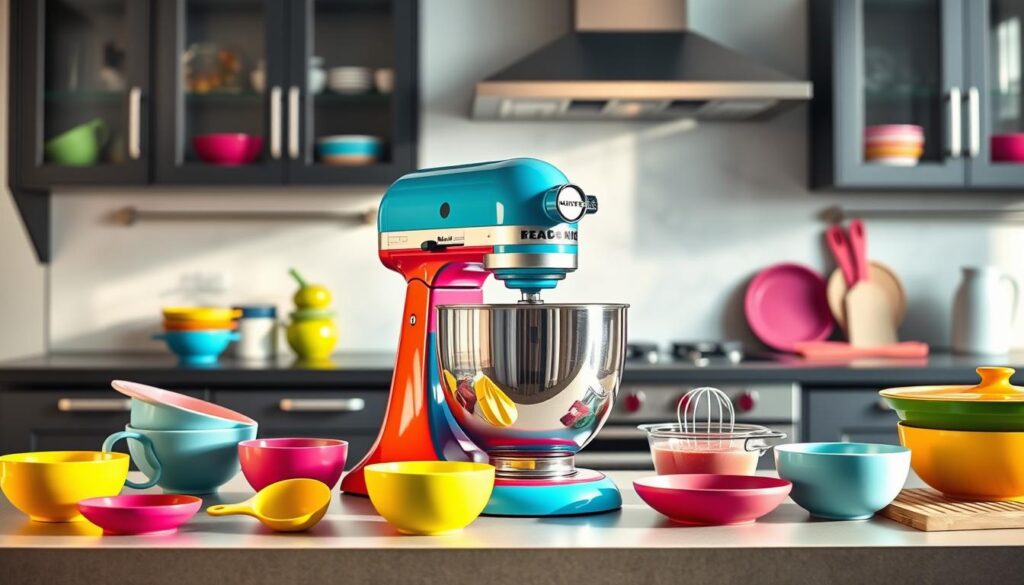
By incorporating stand mixers into your collection of cooking tools, you take a step towards efficiency and creativity in your kitchen. Whether you’re a novice cook or an experienced chef, these devices can serve as invaluable assets that elevate your culinary skills.
Understanding Essential Tongs and Spatulas in Your Kitchen
In the realm of kitchen utensils, essential tongs and spatulas stand out as fundamental tools for any home cook. Their versatility not only makes them indispensable but also enhances your efficiency in the kitchen. For flipping, serving, and sautéing, quality tongs can significantly influence your cooking experience.
When selecting essential tongs, it’s wise to invest in models with firm springs. Tongs made from stainless steel paired with rubber tips provide a firm grip and are perfect for a variety of tasks, from grilling to tossing salads. Having a pair of each kind can understand the nuances of what works best for different cooking needs.
Spatulas are equally important as culinary accessories. Rubber spatulas are frequently used for cleaning the bottoms of bowls and are designed to withstand high heat, making them ideal for many cooking applications. Metal spatulas, however, offer superb versatility by allowing you to move food in the pan, spread frosting over cakes, and serve dishes with ease.
To further enhance your kitchen, consider including tools such as Microplane graters, which are excellent for zesting citrics or grating hard cheeses, providing essential functionality. Additionally, a good set of strainers can be invaluable for sifting and straining sauces or soups, especially if they feature finely woven metal construction.
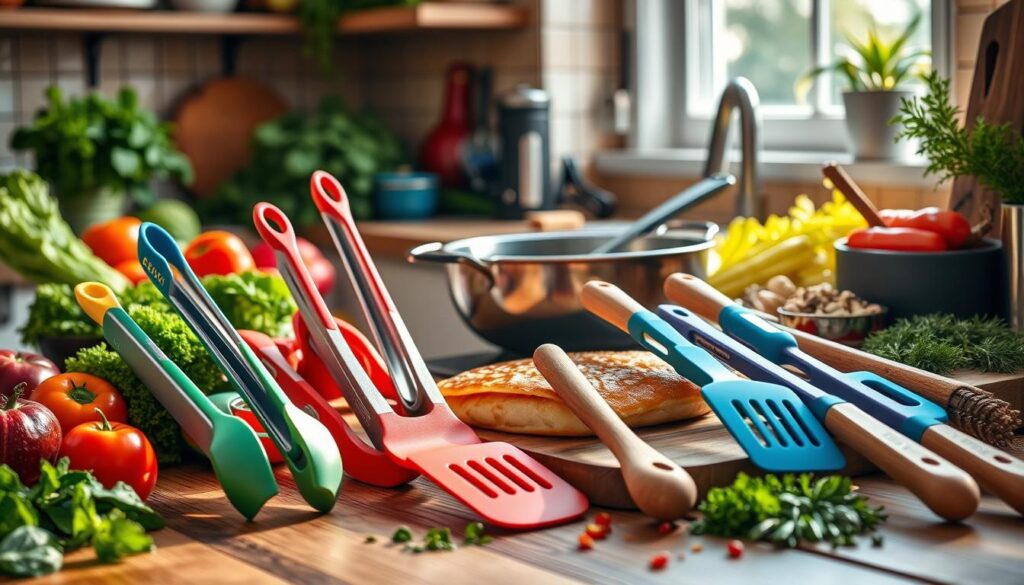
In terms of organization, adding digital kitchen scales can help you achieve accurate measurements. This is particularly useful in transitioning recipes to grams for consistency. Likewise, a reliable thermometer ensures that your dishes are cooked to safe temperatures, while high-quality kitchen shears can assist in a plethora of tasks, from cutting parchment to scoring bread.
| Tool Type | Functionality | Recommended Material |
|---|---|---|
| Essential Tongs | Flipping, serving, tossing | Stainless steel with rubber tips |
| Rubber Spatulas | Mixing, scraping, cleaning bowls | Heat resistant rubber |
| Metal Spatulas | Flipping, spreading, serving | Stainless steel |
| Microplane Graters | Zesting, grating | Stainless steel |
| Heavy-Duty Strainers | Sifting, straining | Finely woven metal |
In essence, incorporating essential tongs and spatulas into your kitchen tools will enhance your cooking experience. Choosing quality over quantity ensures that your culinary adventures are both enjoyable and efficient, making these two tools crucial in your collection of kitchen utensils.
Why You Need a Quality Food Processor
Investing in a quality food processor unlocks numerous advantages that transform your cooking experience. The food processor importance lies in its ability to handle various tasks efficiently, making it one of the most valuable essential cooking tools in your kitchen. Whether you need to chop vegetables, shred meats, or knead dough, a food processor simplifies the process dramatically.
Different brands offer models to suit various needs and budgets. For instance, the Magimix 5200XL features a robust 1100 watts of power and a generous 3.6 liters capacity, making it perfect for families or frequent cooking endeavors. On the other hand, the Kenwood FPP 225, priced around 70 Euros, provides an entry-level option that excels at making hummus and pestos but may fall short for more robust tasks such as kneading stiff doughs.
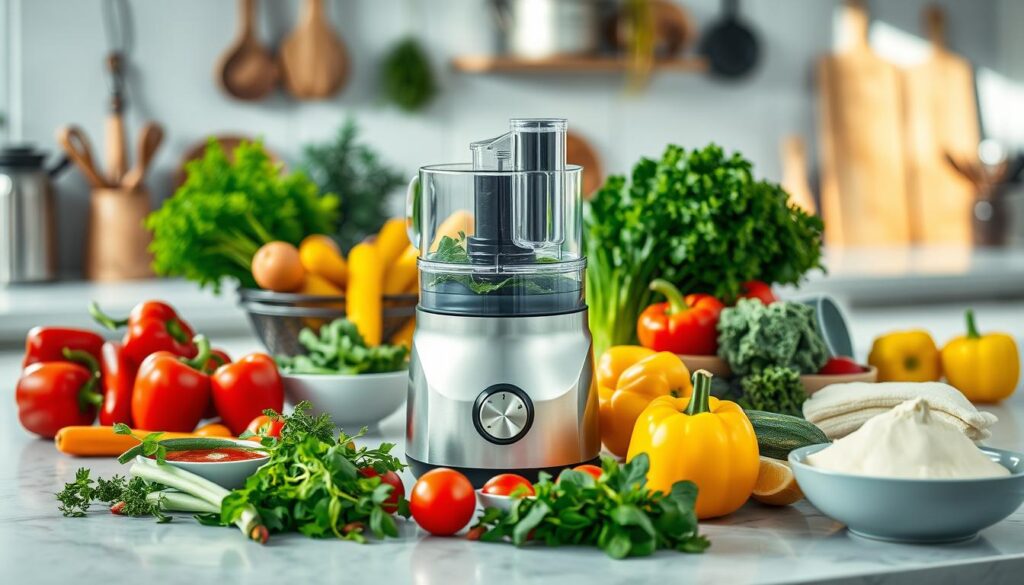
Your choice should consider factors like size constraints, budget, and whether you intend to engage in more advanced culinary tasks. Food processors operate best with at least 600 watts for heavy-duty jobs, such as nut butter or energy ball recipes. Smaller models, around 1.6 liters, cater to smaller households, while larger ones accommodate family meal preparations efficiently.
In comparison to other kitchen gadgets, such as blenders, food processors stand out when it comes to tasks like grating cheese or preparing pesto. While blenders excel at creating smoothies and purees, food processors provide greater versatility in preparing a wide range of textures and ingredients.
A quality food processor not only enhances efficiency but also expands your culinary capabilities. By streamlining meal prep, you can enjoy a more enjoyable cooking experience while experimenting with new recipes and ingredients.
Exploring Chef Gadgets That Make Cooking Easier
In today’s culinary landscape, a variety of chef gadgets exist to make cooking a smoother and more enjoyable experience. These smart kitchen tools are designed to streamline your cooking process, whether you’re a seasoned pro or just starting out. Embracing these cooking tools and gadgets can transform how you approach meal preparation, enhancing both efficiency and creativity.
Popular Smart Kitchen Gadgets
Many innovative smart kitchen gadgets have gained popularity among home cooks. These gadgets often connect to apps, enabling automation and easily manageable cooking tasks. Here are some top picks:
- Instant Pot: A staple in numerous kitchens, this multi-functional appliance can sauté, steam, slow cook, and even make yogurt.
- Air Fryer: A healthier alternative for frying, it circulates hot air with minimal oil.
- Food Processor: Known for versatility, this gadget quickly chops, slices, shreds, and purees ingredients.
- Sous Vide Precision Cooker: Allows for precise temperature control in a water bath, resulting in perfectly cooked dishes.
- Smart Kitchen Scale: Features like Bluetooth connectivity aid in precise baking and cooking by connecting to recipe apps.
- Immersion Blender: Ideal for blending soups and sauces directly in their pots.
Affordable Chef Gadgets for Beginners
For those new to cooking, there are plenty of affordable chef gadgets that can make starting out much simpler:
- Electric Wine Opener: Makes opening wine bottles hassle-free.
- Herb Stripper: Easily removes leaves from stems, perfect for fresh herbs.
- Electric Kettle: Efficiently boils water for tea or instant noodles.
- Kitchen Thermometer: Essential for checking meat temperatures while grilling or baking.
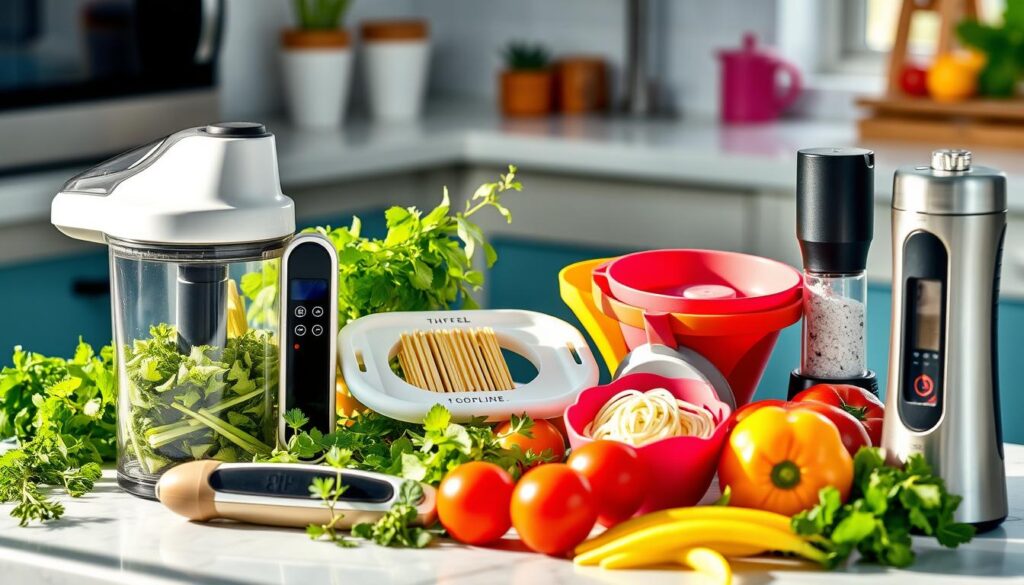
Investing in these chef gadgets ensures you have the tools necessary to explore your culinary talents with confidence. Discovering how these smart kitchen tools can elevate your cooking experience will inspire your next meal.
| Gadget | Description | Rating |
|---|---|---|
| Instant Pot Duo | Multi-cooker with sauté, steam, and slow cook functions. | 5/5 |
| Ninja Creami | Ice cream and frozen dessert maker. | 4.5/5 |
| ProCook Air-Fryer Health Grill | Healthier frying with hot air circulation. | 5/5 |
| Kenwood MultiPro Go | Versatile food processor. | 5/5 |
| Electric Kettle (Tesco) | Boils water quickly for various needs. | 5/5 |
| Lakeland Slow Cooker | Perfect searing and slow cooking. | 5/5 |
Culinary Accessories to Enhance Your Cooking Experience
Every kitchen deserves the charm and efficiency that culinary accessories bring. From innovative kitchen gadgets to smart tools that simplify meal preparation, your cooking experience can truly be transformed. Consider integrating items such as smart pressure cookers and automatic pan stirrers to elevate the way you cook.
Modern coffee makers have advanced significantly, featuring fast water heating and options for multiple cup sizes. Frothers add an extra level of finesse for those who enjoy specialty beverages. Meanwhile, smart kitchen scales can connect to your devices, providing precise measurements for recipe accuracy.
Imagine controlling your recipes via smartphone with a smart air fryer or monitoring toasting progress on a touchscreen smart toaster. These culinary accessories make it easier than ever to achieve the perfect meal. Other tech-savvy items include electric kettles for quick boiling and smart thermometers to track dish temperatures conveniently.
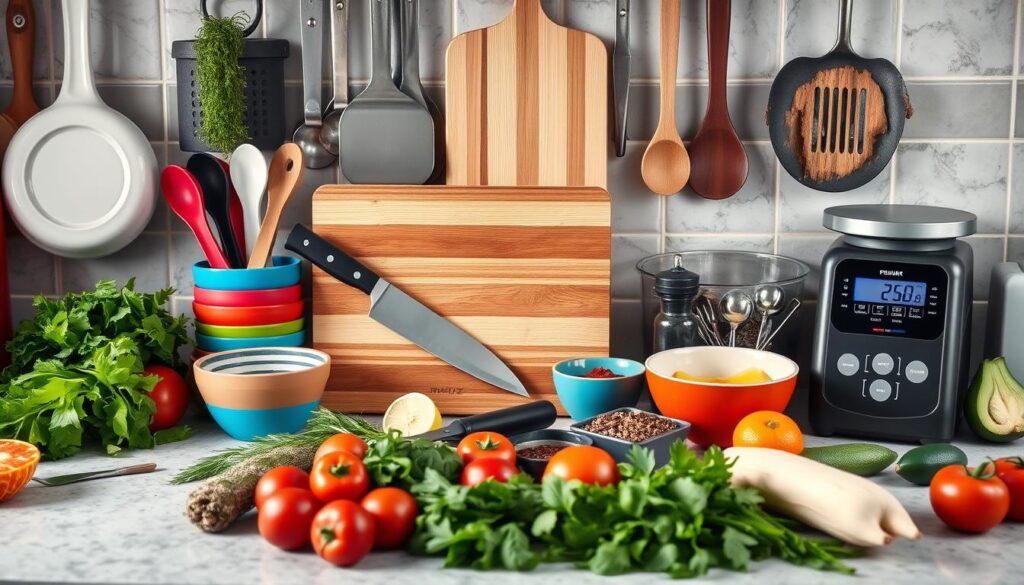
Incorporate unique gadgets like touchless trash cans and motion-censored faucets to maintain a clean and efficient workspace. With an impressive range of over 25 advanced cooking tools and gadgets available today, from versatile cast iron skillets to elegant food processors, embarking on your culinary journey becomes exciting and fulfilling.
| Culinary Accessories | Features |
|---|---|
| Smart Pressure Cookers | Enhanced functionality with programmable options |
| Automatic Pan Stirrer | Stirs dishes automatically for multitasking |
| Smart Air Fryer | Recipe control via smartphone app |
| Smart Mug | Temperature control with smartphone integration |
| Smart Thermometer | Connects to devices for accurate temperature monitoring |
| Electric Kettle | Fast boiling for tea, coffee, or cooking |
Enhancing cooking with the right culinary accessories not only improves efficiency but also adds joy to the process. Dive into the world of smart kitchen gadgets and discover how they can revolutionize your culinary adventures.
The Must-Have Measuring Tools for Accuracy
Accurate measuring tools stand out as crucial kitchen essentials, particularly when it comes to cooking and baking. Achieving consistent results in your recipes requires reliable measuring cups and spoons. Let’s explore your options for selecting the best measuring tools, ensuring you make informed decisions tailored to your kitchen needs.
Your Options for Measuring Cups and Spoons
When searching for the right cooking tools and gadgets, several respected brands offer exceptional measuring spoons that excel in precision. Below are some top choices based on accuracy and overall performance:
| Measuring Tool | Average Measurements | Price | Notes |
|---|---|---|---|
| Sur La Table Spice Measuring Spoons | 1 tablespoon – 15.975 grams, 1 teaspoon – 5.275 grams | $22 | Tied for first in accuracy testing |
| Amco Advanced Performance Measuring Spoons | 1 tablespoon – 15.975 grams, 1/4 teaspoon – 1.8 grams | $17 | Durable and accurate |
| RSVP International Endurance Spice Spoons | 1 tablespoon – 14.86 grams, 1/4 teaspoon – 1.275 grams | $Management | Great for spices with precise measurements |
| Cuisipro Silver Measuring Spoon Set | 1/2 teaspoon – 2.625 grams | $Management | High accuracy among tested sets |
| U-Taste Stainless Steel Measuring Spoons | Variety of measurements (1/16 teaspoon to 1 tablespoon) | $Management | Versatile for various recipes |
In your search for the best measuring tools, consider options with rings to hold measuring spoons together instead of chains, as they allow for easier access. NIST defines one tablespoon as equal to 15 milliliters, with one teaspoon being approximately 5 milligrams. Such accuracy is crucial for baking tasks, where precise measurements can significantly affect your culinary results.

Conclusion
As you explore the world of culinary creation, the importance of having the right kitchen essentials cannot be overstated. Essential cooking tools and gadgets go beyond mere convenience; they enhance the joy of cooking and empower you to experiment with new recipes. It’s evident that investing in quality equipment, from versatile chef’s knives to trusty tongs, will not only streamline your food preparation but also elevate your culinary skills.
Additionally, understanding the variety of cooking tools and gadgets available—such as baking utensils, measuring tools, and specialized kitchen gadgets—enables you to tailor your kitchen to fit your specific needs. These essentials, whether crafted from durable stainless steel or flexible silicone, serve crucial roles in both everyday cooking and extravagant culinary escapades.
In conclusion, embracing well-chosen kitchen essentials allows you to embark on exciting culinary adventures while ensuring each dish you create is a masterpiece. By carefully selecting your cooking tools and gadgets, you’re setting yourself up for success and satisfaction in every meal you prepare.
